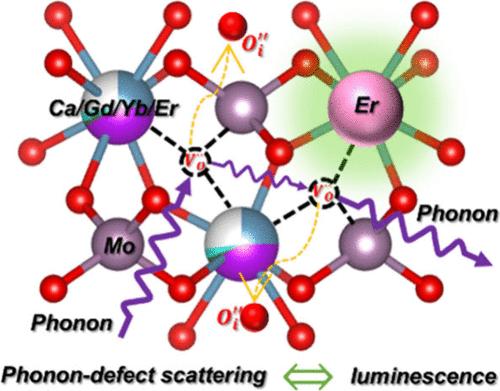当前位置:
X-MOL 学术
›
J. Phys. Chem. Lett.
›
论文详情
Our official English website, www.x-mol.net, welcomes your
feedback! (Note: you will need to create a separate account there.)
Luminescence and Transport Behavior in Incommensurately Modulated CaGd2(MoO4)4:Yb/Er
The Journal of Physical Chemistry Letters ( IF 4.8 ) Pub Date : 2024-11-06 , DOI: 10.1021/acs.jpclett.4c02554
Yinghan Wang 1 , Zeyue Zhang 2 , Guohong Cai 2 , Jingxie Xiong 1 , Zhengren Tao 1 , Chunhai Wang 3 , Junliang Sun 2 , Shi Ye 1
The Journal of Physical Chemistry Letters ( IF 4.8 ) Pub Date : 2024-11-06 , DOI: 10.1021/acs.jpclett.4c02554
Yinghan Wang 1 , Zeyue Zhang 2 , Guohong Cai 2 , Jingxie Xiong 1 , Zhengren Tao 1 , Chunhai Wang 3 , Junliang Sun 2 , Shi Ye 1
Affiliation

|
The phenomenon of thermal quenching of luminescence can significantly compromise the efficiency of luminescent materials, a process accompanied by the generation of substantial phonon populations. While plenty of models for elucidating this behavior have been proposed, the crucial role of phonon transport has largely been neglected, particularly in the enigmatic incommensurate scheelite structure with good luminescence performance. In this study, we delve into the thermal quenching dynamics of the near-infrared emission in the incommensurately modulated CaGd2(MoO4)4:Yb/Er system. Our comprehensive investigation reveals distinct evolutionary patterns in electrical conductivity, luminescence intensity, thermal conductivity, and Raman scattering at varying temperature regimes. Notably, we have determined that thermally induced ion migration, occurring above ∼300 °C, serves as a pivotal trigger for the activation of all phonons and the enhancement of phonon–defect scattering within this incommensurate framework. This phenomenon not only diminishes the thermal conductivity but also accelerates the multiphonon relaxation of the Er3+ emission levels, culminating in a marked thermal quenching of luminescence. This work illuminates the thermal quenching mechanism of luminescence by focusing on phonon scattering dynamics, providing critical insights for the design of thermally robust near-infrared luminescent materials, which are essential for the advancement of optical amplification systems.
中文翻译:

不相称调制的 CaGd2(MoO4)4:Yb/Er 中的发光和传输行为
发光的热猝灭现象会显着降低发光材料的效率,这一过程伴随着大量声子群的产生。虽然已经提出了大量模型来阐明这种行为,但声子传输的关键作用在很大程度上被忽视了,特别是在具有良好发光性能的神秘不相称的白钨矿结构中。在本研究中,我们深入研究了不对称调制的 CaGd2(MoO4)4:Yb/Er 系统中近红外发射的热猝灭动力学。我们的全面研究揭示了不同温度条件下电导率、发光强度、热导率和拉曼散射的不同进化模式。值得注意的是,我们已经确定,发生在 ∼300 °C 以上的热诱导离子迁移是在这个不相称的框架内激活所有声子和增强声子缺陷散射的关键触发因素。这种现象不仅降低了热导率,还加速了 Er3+ 发射水平的多声子弛豫,最终导致发光的显着热猝灭。这项工作通过关注声子散射动力学阐明了发光的热猝灭机制,为设计热鲁棒性近红外发光材料提供了重要见解,这对于光学放大系统的发展至关重要。
更新日期:2024-11-06
中文翻译:

不相称调制的 CaGd2(MoO4)4:Yb/Er 中的发光和传输行为
发光的热猝灭现象会显着降低发光材料的效率,这一过程伴随着大量声子群的产生。虽然已经提出了大量模型来阐明这种行为,但声子传输的关键作用在很大程度上被忽视了,特别是在具有良好发光性能的神秘不相称的白钨矿结构中。在本研究中,我们深入研究了不对称调制的 CaGd2(MoO4)4:Yb/Er 系统中近红外发射的热猝灭动力学。我们的全面研究揭示了不同温度条件下电导率、发光强度、热导率和拉曼散射的不同进化模式。值得注意的是,我们已经确定,发生在 ∼300 °C 以上的热诱导离子迁移是在这个不相称的框架内激活所有声子和增强声子缺陷散射的关键触发因素。这种现象不仅降低了热导率,还加速了 Er3+ 发射水平的多声子弛豫,最终导致发光的显着热猝灭。这项工作通过关注声子散射动力学阐明了发光的热猝灭机制,为设计热鲁棒性近红外发光材料提供了重要见解,这对于光学放大系统的发展至关重要。

































 京公网安备 11010802027423号
京公网安备 11010802027423号